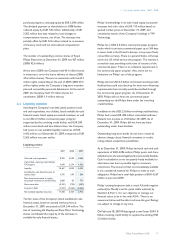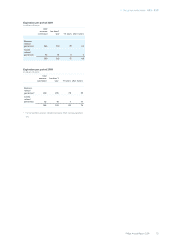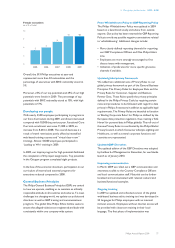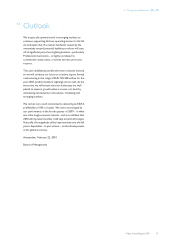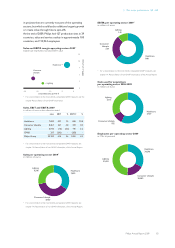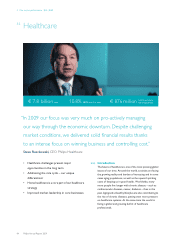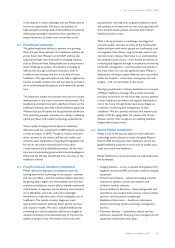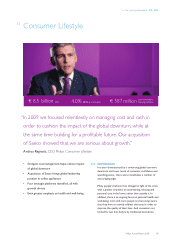Philips 2009 Annual Report Download - page 79
Download and view the complete annual report
Please find page 79 of the 2009 Philips annual report below. You can navigate through the pages in the report by either clicking on the pages listed below, or by using the keyword search tool below to find specific information within the annual report.
We require our suppliers to pay for the third-party audits,
believing this is an effective way of embedding our
requirements in the supply chain.
Average non-compliances per audit
25
20
15
10
5
0
13
Brazil
14
China
3
Indonesia
22
India
13
Mexico
3
Thailand
17
Others
Distribution of non-compliances by grouping
as a % of Bill of Material-related audits in risk countries
Environmental
14
Ethics
3
Health and
safety
17
Labor
18
Management
system
48
Follow-up audits to check corrective actions are
conducted by Philips personnel. This approach is well
accepted and appreciated by our suppliers as it helped
improving their performance. Where no improvements
could be achieved, 12 suppliers were phased out.
Strengthening the organization
In 2009 we moved the functional responsibility for the
Supplier Sustainability Involvement Program to China to
embed the program in the Asian procurement
organization. With our personnel working directly with
suppliers and buyers, we can address issues more
effectively in a local context.
Auditing Philips sites
Mirroring our supplier approach, 12 internal Philips sites
in risk countries were audited by a third party using the
EICC checklist. All non-conformities have been resolved
or are being resolved in accordance with Philips’ strict
resolution timelines.
Supply chain carbon footprint
In 2008 we selected six products and assessed CO2
emission of their components throughout the supply
chain. The goal of this pilot project was to create
awareness in our supply base, identify large sources of
emissions per product type and implement abatement
measures collaboratively with our suppliers. We
continued this exercise in 2009 by analyzing four more
products. Additionally, to further improve measurement
and increase understanding of supply chain CO2
emissions, we subscribed to the EICC Carbon Reporting
System. This online system allows companies in the
electronics industry to calculate their greenhouse gas
emissions and share the data with other companies in the
industry.
‘Conflict’ minerals: issues further down the
chain
Philips acknowledges the issues concerning working
conditions at the base of the supply chain, specifically in
the extractives sector for metals such as tin, tantalum and
tungsten. In particular, we are concerned about the
situation in the east of the Democratic Republic of the
Congo where proceeds from the extractives sector are
sometimes used to finance rebel conflicts in the region.
EICC members stated in February 2009 that mineral
extraction and transport activities that fuel conflict are
not acceptable. Philips participates in the EICC Extractives
Work Group, which initiated an industry project in April
2009 to develop supply chain transparency, with a
particular focus on cobalt, tin, and tantalum. The project
will attempt to identify participants in these supply chains
and to obtain information from suppliers relating to
conformance to the EICC Code of Conduct and similar
programs.
Along with several other leading electronics companies,
we convened a multi-stakeholder workshop in San
Francisco in October 2009 to engage other sectors and
interested stakeholders. We also have had meetings with
the Dutch government to see what role government and
other institutions can play in resolving the issue of conflict
minerals.
4 Our group performance 4.3.9 - 4.3.9
Philips Annual Report 2009 79




